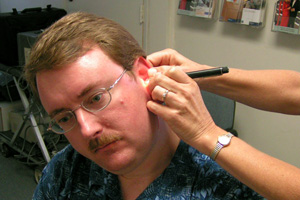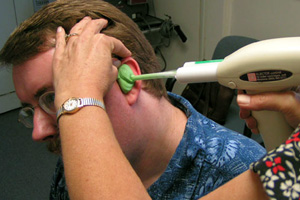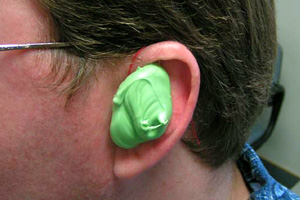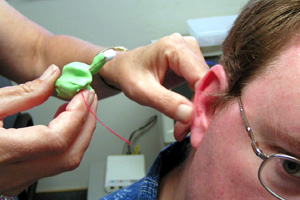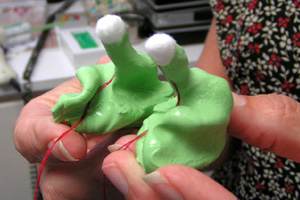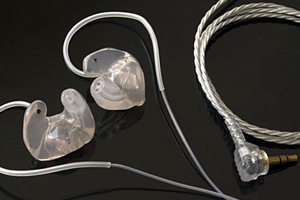![[SoundStage!]](../sslogo3.gif) All In Your Head All In Your HeadBack-Issue Article |
||||||||||
February 2005 Sensaphonics Hearing Conservation ProPhonic Soft 2X Headphones In the world of headphones, in-ear monitors are currently garnering a lot of attention and experiencing a great deal of growth. What are in-ear monitors? Think of them as full-range headphones that are shrunk down to tiny devices that are nearly invisible once inserted into your ears. They incorporate one or more micro-transducers inside miniscule housings. In-ear monitors, or canal 'phones, can be broken down into two main categories: generic and custom-fit. To keep the costs to the consumer down, manufacturers of generic canal 'phones use silicon and/or foam tips over the stalk that holds the micro transducer. While these generic tips work well for most people, they trade lower cost for reduced comfort. The custom-fit approach provides incredible comfort but has two drawbacks: a higher price and a complete lack of resale value because they fit only the owner’s ears. This month’s report is on the $750 USD Sensaphonics ProPhonic Soft 2X, a pair custom-fitted in-ear monitors. They come standard with permanently attached 48" Teflon-coated wires that are terminated in a 1/8" headphone jack. (There is an optional break-away cord available in a standard 50" length; custom lengths are available.) The shell that houses the two drivers is made of pure silicon, which is surprisingly soft and supple. The color options available are: clear, black, white, red, yellow, orange, pink, blue, purple, and a swirl of your choice of any two or three colors. The ProPhonic Soft 2X's are rated at 27 ohms and has a sensitivity of 109dB/W/m. Each pair of ProPhonic Soft 2X monitors arrives in a hard carrying case with the owner’s name on the front. The case comes with a cleaning tool for removing anything that gets into the sound tubes, a pocket storage pouch, a shirt clip, and a 1/8"-1/4" adapter for use with full-sized headphone jacks. The process of getting a pair of ProPhonic Soft 2X monitors begins with having impressions of your ears made by a qualified audiologist. Sensaphonics maintains a list of recommended audiologists with experience in making impressions for Sensaphonics products, and the company quickly put me in touch with one in my local area. My audiologist, Blanche, started out by asking for which Sensaphonics product I was being fitted. She explained that it makes a difference, as each product requires an impression to a different depth. Blanche began by making two small wads of cotton with some thread attached. Using a small lighted wand, she inserted a wad all the way into each of my ears. After that she took a device that mixes and pumps the two materials that make the impressions, and proceeded to fill my ears with the substance. It dried in a couple of minutes, and with a slight twisting motion it was easily removed. With that my impressions were complete. The whole process took about half an hour, including some small talk about hearing conservation and ear hygiene. Once completed, the impressions are sent to Sensaphonics where they are converted into silicon molds, which are used to create the in-ear monitors that house all the necessary wiring, the crossover, the sound tubes, and the micro transducers. The standard turnaround time is one week from when Sensaphonics receives the impressions. When your completed 'phones return, you should schedule a fitting appointment with your original audiologist, who will give instructions on insertion and extraction, and will help you verify the quality of the fit. Later, when you get your in-ear monitors home, make sure to spend some additional time checking the seal, fit, and comfort. You can tell when you get a good seal as the bass is lessened considerably when the seal is not properly made. The fit is guaranteed by Sensaphonics, and if there is a problem Sensaphonics will remake your 'phones free of charge for up to 30 days. I had to send my pair back as one was too long and rested painfully against the rear of my ear. After the remold, it fit perfectly and has been pain-free ever since.
After an extended break-in of well over 400 hours, I excitedly sat down for some critical listening. I began with the familiar Fleetwood Mac Rumours on DVD-A [Warner Brothers Records 9362-48083-9]. Quickly, the first thing to stand out about these in-ear monitors became evident: The sound they created was incredibly fast. The attack and decay of the music were simply amazing. The rapid-fire guitar work, drums, and piano just jumped out at me as never before. Lindsey Buckingham’s guitar sounded like he was in the room with me, playing his guitar for an audience of one. I guess a driver just a few millimeters across dramatically improves the speed of the sound it has to produce. It didn’t take long before the next attribute of the ProPhonic Soft 2X's made itself clear, this time in the bass, which was amazingly deep and tight, and not of the one-note variety in the least. Kickdrum hit hard and fast, and it faded away without a hint of overshoot or overhang. The ability to reproduce really low bass made me want to find out just how low these tiny micro-transducers could go. With that I broke out Bass Mekaniks Quad Maximus [Pandisc PD-8148]. This disc has a five-second recording of each individual bass note from 10Hz-100Hz in 1Hz increments. With most full-sized headphones, I can hear usable bass down to 34Hz. The ProPhonic Soft 2X monitors were able to extend all the way down to 26Hz, and by 30Hz it sounded like someone turned on a subwoofer in the room. Another of the many benefits of the ProPhonic Soft 2X's reveals itself while traveling. The 26dB of isolation they provide is welcome on flights and noisy buses, for car and train rides. I had the pleasure of using the review pair during a nine-hour flight to South America. With no music playing, the ProPhonic Soft 2X's almost completely blocked the drone of the jet engines and the rush of air over the fuselage. When the music was playing, it drowned out whatever external noises there were. Foam earplugs or generic-fitting silicon canal 'phones make my ears itch, and are uncomfortable for long-term use. After using the ProPhonic Soft 2X's for nine-hours I was pleasantly surprised that, for the first time after the long trip to South America, my ears didn't itch and weren't irritated. The Sensaphonic headphones' ability to block external sounds gives two distinct advantages over standard headphones: lower volume settings for normal listening, and improved detail and microdynamics. The ProPhonic Soft 2X's nearly eliminate competition with the everyday noises you no longer pay attention to but still interfere with your musical enjoyment. The neighbor’s dogs barking, cars and buses passing by, your keyboard clicking as you type, fans and air conditioners running, the baby crying -- all these sounds and more are greatly reduced by the Sensaphonics monitors. Also, by reducing or blocking external noises, these 'phones allow you to hear things in your music that went unnoticed before. Very subtle notes and background voices are now apparent, making the music more enjoyable than ever before in my book. Stevie Nicks’ voice, which has a very unique sound to it, comes across with all its subtle quivers with the ProPhonic Soft 2X 'phones. This quality is extremely apparent on "Dreams", track 2 of the Rumours DVD-A. With lesser headphones, you simply won’t get the real Stevie Nicks, just some lessened imitation.
I compared the ProPhonic Soft 2X headphones to the $330 Etymotic ER-4S model. Due to their popularity, the Etymotics are the de facto standard by which canal 'phones are measured. As such, I think it proves valid and helpful to compare them to the ProPhonic Soft 2X's, even with the big price difference. To begin with, I believe that comfort is the most important factor when it comes to canal 'phones. If you can’t wear them due to discomfort, all sonic merits are meaningless. In this respect the comparison isn’t even close. The Etymotics are painful -- always. I never forget they’re in my ears as they exert a constant, nagging pressure on my ear canals. Each insertion is painful, and each extraction a relief. When it comes to bass depth and impact, the Sensaphonics are superior to the Etymotics. The Sensaphonics’ bass has extension that reaches to well below that of the Etymotics. Due to the leaner bass response, the Etymotic 'phones have what sounds like a tipped-up response. This effect makes for more fatiguing listening sessions. The overall frequency balance of the Sensaphonics 'phones is slightly on the warm side, while the Etymotic 'phones tend to sound a little dry. One amazing discovery was that the Etymotics don’t do female vocals very well. They sound unnatural to my ears, and have a strong tendency toward sibilance. Overall, the Sensaphonics ProPhonic Soft 2X monitors represent a major improvement in every way possible over the Etymotic ER-4S 'phones. I have one caveat about the ProPhonic Soft 2X's: They are extremely sensitive to volume-control changes. Stepped attenuators normally make finding the desired volume level difficult, and with the Sensaphonics 'phones this issue is made worse. Smooth potentiometers, due to their tendency to be mismatched in their left-right balance at lower volume settings, can also tend to make finding the right volume level difficult. For instance, the left channel of the Single Power Audio PPX3-6SN7 I used was lower in volume than the right, so I had to compensate by turning the volume up slightly to maintain balance. Overall, I was extremely impressed with the sound and build qualities of the ProPhonic Soft 2X in-ear monitors. After more than four months of testing and trying, I’m happy to report that I couldn’t find a single fault with them -- they did everything very well. These wonderful in-ear monitors are at home with every type of music I threw at them. While somewhat expensive, they represent a near-perfect blend of sound quality, comfort and isolation, and their balanced sound always left me wanting to spend time listening. I guess that’s the highest compliment to give -- the ProPhonic Soft 2X's always leave me wanting to listen more. ...Doug Paratore
|
||||||||||
|
||||||||||
![[SoundStage!]](../sslogo3.gif) All Contents All ContentsCopyright © 2005 SoundStage! All Rights Reserved |
